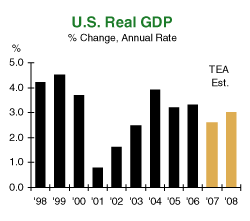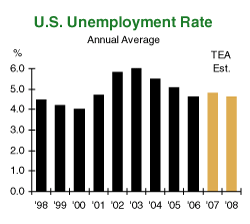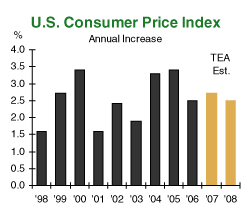|
March 14, 2007
Springtime View
Written by Jeff Thredgold, CSP, President, Thredgold Economic Associates
 The American Economy The American Economy
…moderate growth continuing
U.S. economic growth near a 2.5%-2.8% real (inflation adjusted) annual rate seems likely over the balance of the year. Weakness in the housing and automotive sectors should be offset by solid growth in services. We don’t subscribe to the recession view pushed by a noisy few, although odds of a recession have risen.
The Federal Budget
…lesser red ink
Powerful gains in corporate and individual tax receipts reduced the budget deficit for fiscal year (FY) 2006, which ended last September 30, to $248 billion. This compares to the $318 billion shortfall in the prior year. A budget deficit around $200 billion seems on tap for FY2007, while budget issues become more challenging in coming years.
Employment
…tight and tighter
The American economy added nearly seven million net new jobs during 2004 to 2006, a solid rise. The issue of tighter labor availability—especially for skilled workers—will challenges businesses of all shapes and sizes in coming years.
The nation’s unemployment rate averaged 4.6% during 2006 and in early 2007, a five-year low. By comparison, the jobless rate averaged 5.3% in 2004/05 and 5.9% in 2002/03. Monthly job gains have slowed. We expect the unemployment rate to average 4.6%-4.9% in 2007 before moving lower in subsequent years.
Inflation
…tied to oil
Declines in energy prices sharply reduced inflation pressures in 2006’s final months. The Consumer Price Index rose only 2.5% last year, versus 3.4% in 2005, 3.3% in 2004, and 1.9% in 2003. Most forecasters see 2007 consumer inflation near 2.5%-2.8%.
The Federal Reserve
…on the sidelines
The Federal Reserve has now been on the monetary sidelines for nine months, following 17 consecutive 0.25% hikes (to 5.25%) in the critical federal funds rate between June 2004 and June 2006. Prior to that period, the federal funds rate was at a 46-year low of 1.00% for 12 months.
Most forecasters expect the Fed to remain on hold through 2007’s first half, with a possible move or two to the downside during the second half. Subprime lender anxiety could lead the Fed to cut sooner. A vocal minority of economists still expect the Fed to tighten later in the year.
Long-Term Interest Rates
…recently trending lower
Thirty-year fixed-rate mortgages declined to the 6.00%-6.125% level in early to mid-March. I would suggest that mortgage rates have peaked for this cycle, with rates possibly moving to “the very high 5s” by mid-year 2007.
Home Prices
…more realistic pricing
Surging home prices on both coasts and in the Southwest during the past five years gave way to a buyers’ market more recently. The simple reason? The average American home rose 55.21% between 2001 and 2006. Florida?…up 106.90%. California?…up 105.80%. Nevada? Up 99.35%. Arizona?…up 96.55%.
Home owners and “flippers” simply pushed prices too far, requiring the current painful downward adjustment. We expect greater home price strength in the nation’s interior as relative values (compared to the coasts) are attractive.
The Global Economy
…powerful growth continues
Solid global economic growth is expected in 2007, following impressive growth during the prior four years. Solid growth for 4-5 straight years would be the first such occurrence since the early 1970s. As before, risks to this view include any major new terrorist atrocities (especially on American soil), much higher oil prices, and a worsening of Middle East tensions.
Any discussion of the Pacific Rim must begin with Japan, a nation that still accounts for more than half of all Asian economic output and still ranks as the world’s second largest. Japan returned to modest economic growth during the past 36 months…following “the lost decade” of economic stagnation. Rising exports to China and stronger consumer spending have benefited the Japanese economy. The eight-year battle with deflation has given way to extremely low inflation.
China? Powerful economic growth has led to serious environmental damage, with polluted air in major cities and poisoned rivers the norm. A “green movement” is underway in China.
India’s economy continues to perform well, although an infrastructure of two-lane national highways and antiquated airports, sewers, & water systems must be addressed. Most other economies in the Pacific Rim are performing reasonably well.
The European economy has strengthened, with real growth near 2.5%, the best in six years. Kingpins Germany and France still struggle with jobless rates near 10.0% and 9.0%, respectively. Long-awaited labor reforms bode well for greater European competitiveness in coming years. The European Central Bank has raised its key short-term interest rate numerous times since last fall to keep inflation at bay. Additional hikes could occur in 2007.
The Russian economy continues to take advantage of solid oil prices and high oil production, with Russian oil exports now second only to the Saudis. Moves toward greater governmental control and lesser individual freedoms are worrisome to both the citizenry and Kremlin-watchers around the globe.
The South American economy has slowed somewhat. Oil-rich Venezuela remains a political powder keg, with production now in decline.
Canadian economic growth has slowed, although the energy-rich Western provinces are booming. Recent unemployment rates in the “low 6s” are at a 30-year low. The Mexican economy is growing at a reasonable clip, with national political tensions still at sky-high levels following a bitter Presidential election.
The Bottom Line?
U.S. economic growth during the past 36 months has been solid. Stable growth is likely to continue. In addition, we expect: another 12-digit budget imbalance…slowing employment gains…modest inflation pressures…relative stability in both short- and long-term interest rates…soft coastal housing markets, with more solid interior performance…and an anxious but impressive global marketplace.

“Tea”sers
Daffynitions:
Mosquito: An insect that makes flies look good after all
Egotist: Someone who is usually me-deep in conversation
Tomorrow: One of today’s greatest labor saving devices
|
